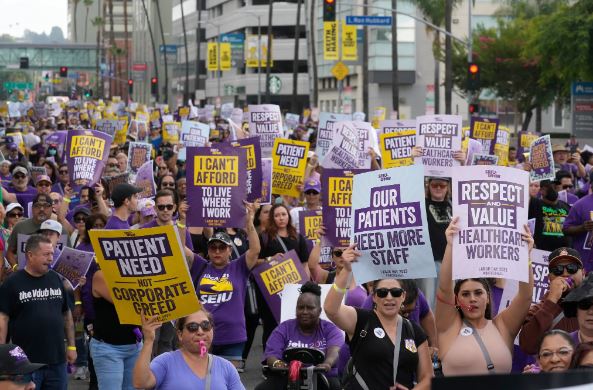If a new labour deal is not reached by Wednesday morning, more than 75,000 Kaiser Permanente employees have threatened to walk out. The prior agreement ended last Saturday. Health care union officials have predicted that this strike may be the biggest in recent U.S. history.
Kaiser is a huge nonprofit health organisation that serves 13 million people throughout eight states and the District of Columbia. This includes California, Colorado, Washington, and seven more states. Members of the support personnel, such as X-ray and laboratory technicians, room cleaners, and pharmacy technicians, would be participating in the strike. These professionals help throughout medical procedures, both in and out of the operating room. The walkout, which is expected to last three days in certain areas, does not include doctors or many nurses. It’s also possible that certain healthcare workers, such as nurses, therapists, and assistants, will strike.
Kaiser has stated that it is making preparations for a potential strike and would do all necessary to keep patients as unaffected as possible. Southern California and Hawaii Kaiser Permanente regional president Michelle Gaskill-Hames affirmed, “Our hospitals are going to remain open,” with their emergency rooms included.
However, patients may have trouble arranging appointments, and non-emergent treatments may be put off.
Union representatives have warned that a strike is imminent due to the stresses of an acute staffing shortage if their concerns are ignored by Kaiser administrators. According to employees, patients at Kaiser facilities are in danger because of insufficient personnel. The unions argue that Kaiser has to increase pay to compete for talent and increase hiring to make up for employee losses seen during the epidemic.
Ms. Lucas said that employees were worried about limited staffing even before Covid struck, despite the fact that the epidemic presented an immediate crisis in which personnel were pushed too thin. A crisis, she said, has been looming for years.
Discussions will continue through Tuesday afternoon. Ms. Gaskill-Hames said that the group would remain in negotiations for as long as was necessary.
She said that Kaiser was experiencing the same difficulties with staffing as the rest of the country’s healthcare facilities. According to her, the company has been more successful than many of its rivals in retaining existing employees and recruiting new ones. Ms. Gaskill-Hames emphasised that the company has become more proactive in its efforts to retain and acquire new employees.
Workers in the healthcare industry are exploding in anger because they say they are being asked to do too much for too little money. Many of the remaining staff are exhausted from trying to meet the needs of an increasing number of patients. New York City nurses went on strike in January over staffing concerns, and there have been more than a dozen more strikes throughout the country this year as well.
Many unionised employees have been encouraged by the tight labour market, leading to a walkout at United Parcel Service that was narrowly avoided and current picket lines among autoworkers. Ruth Milkman, a professor of sociology and labour studies at the City University of New York, has observed that “unions are flexing their muscles in a bunch of industries.”
She said that the widespread shortage of healthcare professionals offers them considerable power to advocate for improved working conditions and greater compensation.
The California Nurses Association is a large organisation that just reached a contract agreement for its members in Northern California.
Kaiser has issued a video and other materials in recent weeks encouraging employees to resist union demands for a walkout. They claim that the public would feel the repercussions of a health worker strike immediately and fatally, in contrast to previous high-profile labour talks, such as those involving autoworkers and Hollywood stars. However, the unions insist that a strike is required to ensure the safety of patients.
A minimum hourly salary for employees and the rate of yearly raises throughout the length of the four-year contract remain contested issues as negotiations continue. The union’s most recent public proposal is for a $25 per hour minimum wage with increments of 7% in the first two years and 6.25 % in the two years thereafter.
Kaiser has responded by boosting its minimum hourly rate to between $21 and $23 beginning in 2020. employees in some regions, such as Northern California, would earn raises of 4% every year for four years, while employees in other regions would receive raises of 3.5% in the first year, followed by rises of 3% per year.

